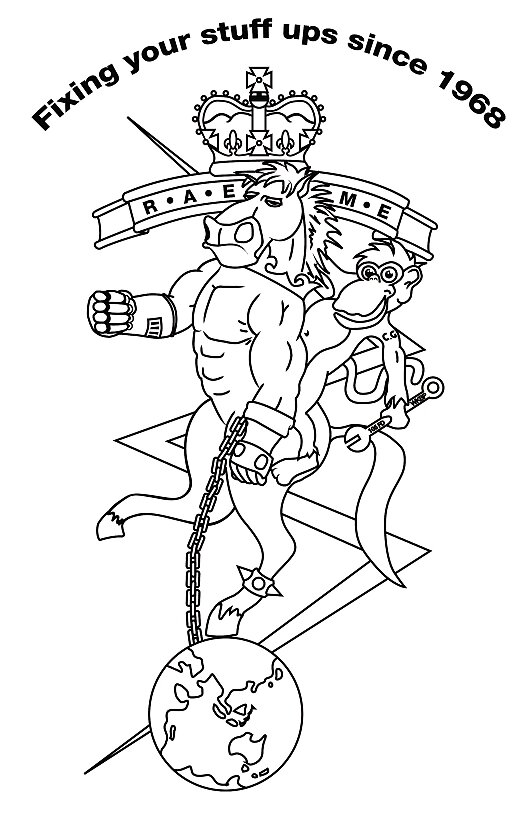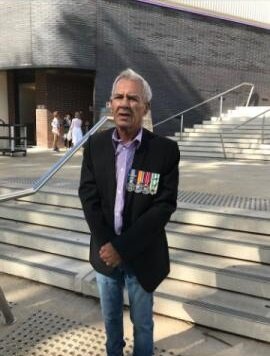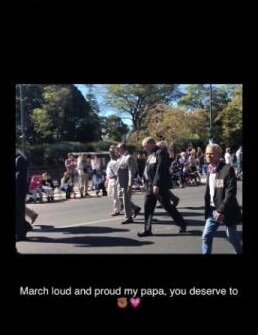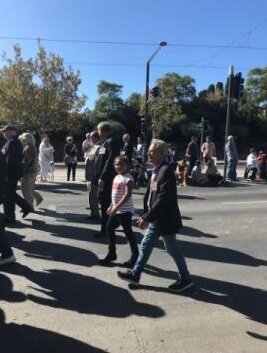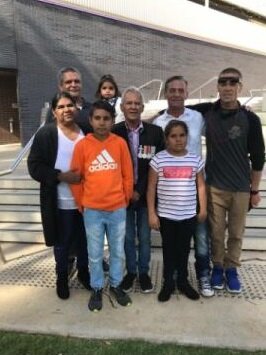A Craftsman and a Monkey - A team during the Vietnam War.
There is a story that has become well known, and I guess, legendary to many family and friends of Richard ‘Shorty’ Sansbury of the 106 Field Workshop RAEME. It concerns an unusual team member he acquired while serving in Vietnam. A story not meant to be presented or portrayed as heroic but one packed with Action, Comedy, Suspense and Drama, and it feels like I am writing a book or movie script as I put this down.
History -
Richard ‘Shorty’ Sansbury
is known today as Bart to many, and his Nharangga language name is ‘Yarluri’, which means “from the ruff sea”. Shorty comes from a strong cultural background and family history. He was born in Wallaroo, South Australia, on the land of his grandfather the Nharangga people and what is known as the Point Pearce Community today.
The Nharangga family, known as Sansbury's, are an original family group whose ancestors lived in an area known as Garnarra (The Northern Yorke Peninsula). They lived in the area of what would become known as Wallaroo, which in the Nharangga language is 'Wadla Waru' and means Wallaby Urine, a part of a Nharangga dreaming story. He is also a descendant of historically known figures of the Adelaide Tribe's area, today known as the Kaurna people.
A sheep property owner acquired a pastoral lease on Nharangga land and had a son named John Sansbury to a Nharangga woman(Queen), the wife of the Nharangga King (Leader). John Sansbury is Shorty's Great-grandfather. John's father, a former opium trader and owner of the sheep property would become a public benefactor, founder of the University of Adelaide, and knighted as Sir Walter Watson Hughes, who is Shorty's 2nd Great-Grandfather.
Sir Walter Watson Hughes (Public Domain)
.
Hughes “claimed” finding Copper on his property in 1859 and establishing the Wallaroo and later Moonta mines, a primary source of South Australian prosperity.
The story of ‘Hughes’ family ties was also brought to light in 2016 by another ‘Sansbury family member, Shorty’s nephew, well-known sportsman Adam Goodes through the documentary series, ‘Who do you think you are?’ Sir Walter Watson Hughes’s deeds and family ties during his time in the Yorke Peninsula are another one of those tucked under the colonial rug secrets, as the fact of John Sansbury being his biological son is still pushed aside as only hearsay.
“I have been a sinner all my life”
- Sir Walter Watson Hughes (Letter to his nephew just before his death in 1887)
Science has advanced in understanding the Y- Chromosomes today, which could be a source of determination.
Who do you think you are Trailer (Youtube)
'Shorty is one of the oldest and last elders of the Nharangga and the Adelaide Tribes on his Grandmother's side today. He was also part of Australia's Stolen Generation, the mixed-race children who were removed from their families and adopted into white Australian families. Shorty was snatched from the local hospital while being treated for measles at nine years old. He was placed into institutions, then adopted into a German Australian family by the name of 'Hartwig' before being conscripted into the Australian army for three years of service, which included two tours of duty in Vietnam.
Example of the justification of the time for the taking of children. Image = A.O. Neville, CC0, via Wikimedia Commons
The “Stolen Generation” is still happening today and is something we must get right. Our colonial crimson ink written history does not match the narrative of certain political members and policymakers today that “the taking of Aboriginal children was simply for their own benefit”. In this regard, the Nharangga and Point Pearce history fly in the face of such political assertions.
["The Point Pearce Mission was one of the best-managed stations in the Commonwealth. The natives themselves had feelings that should be considered. Trouble had been caused in the past by interference from well-meaning people outside, who considered they could control the station better than the manager. Unless it could be shown that the parents were unable or unwilling to look after their children, the Protector of Aborigines had no right to take them away. The way the children were cared for at Point Pearce -would be a credit to any white community']
The Advertiser, Adelaide, SA, 1921.
Fishermen of the Yorke Peninsula.
Shorty’s family were fishermen, people of the sea, like their ancestors before them.
“I remember a lot of my elders that have passed, there are only a few Nharangga men left that can read the land and sea like them. Bart (Shorty) can still tell you what is available to hunt in the water, at what time, and where is the best place to hunt it. He is now in his 70’s is just not physically fit enough to go out on the water alone, he is also not one of those men who can just sit on a boat and watch others do all the work”
- Nharangga Point Pearce Community Member
As a child, Shorty lived at what was known as Hollywood, the fringe camp of the Point Pearce community. He speaks of how he used to go and get water from a well daily when he was seven years old that would come from the sea filtered through the ground. Shorty’s mother’s family, ‘The Smiths,’ were known for fishing in the area and boat building. Shorty’s Great-Grandfather ‘Frederick Snr’ and his sons were known for fishing and building boats along the entire Western Coast of the Yorke Peninsula to Port Pirie. Most built on Point Pearce were at Hollywood and Reef Point fringe camps.
The vessel Narrunga, built in 1903 by the Point Pearce community and used to transport sheep to Wardang Island Photo - Dr Doreen Kartinyeri Collection.
The Smiths built boats in Port Victoria and Moonta. Frederick Snr built his last ship, 25 ft (7.62 m), at Ryan Street in the 1940s, which he sold to a Yorke Peninsula farmer. Many people owned Smith-built boats and chose them ‘because they were strong for the sea’. Shorty and his father, Richard Snr, a Craftsman, also participated in boat building.
“They used to build boats down in Hollywood, you know. Partly old clinker type boats with caulking in them … They’d build them from scratch, you know, you’d sit there next to the shacks and they’d be burning the timber to bend it so it’s right and they’d be caulking it and soaking it” - J. Newchurch
“Fred Smith ‘used to build them and everybody owned them, different people owned them; good sea boats’” - C. O’Loughlin
Vietnam - The 102 Field Workshop, 1st Armoured Squadron and founding of the 106 Field Workshop
Shorty, along with other Nharangga of the Community, followed in the shoes of their elders by serving in Vietnam. Over 70 Nharangga men and women born in the Point Pearce Community alone served in the Australian defence service in World War 1, World War 2, Korea, and Vietnam. The majority are also Shorty’s family, either through his father or mother. He joined the defence service as a Craftsman Mechanic Engineer, servicing and fixing centurion tanks and other Military operated vehicles.
Shorty seems to follow a tradition of making a joke out of a tough time or worry, as he considers his role in Vietnam lucky and coined the term “Holliday Boy” to describe himself.
“He claims that the Vietnam War was the start of his life because of everything he had been through in his childhood, and describes himself as a ‘holiday boy’ to his veteran mates.”
- Artist Brad Darkson
Shorty says:
We would go to the beach at times for Beers and Darts in Vung Tau and also at Nue Dat so it could seem like a holiday. My role allowed me to do many different things compared to others though and I made it home, that was my focus and what I mean by a ‘holiday boy’. I take my hat off to all Veterans for their contribution in the service. We were young men, I look at my Grandsons at 19 years of age and say to myself, ‘I was that age when I went to Vietnam?’.
Artist Brad Darkson was inspired by Shorty's story in the Country Arts SA Vietnam One in, All In exhibition 2019 and designed a neon board that reads 'Holiday Boy' with a palm tree in bright green. This 'Holiday Boy's story is one still noted as his contribution to the service and actions in Vietnam are part of the foundation and history of the 106 Field Workshop today.
Shorty has always been known for his knowledge as a Craftsman. He would fix all of his cars himself no matter where he was travelling around Australia. He would pick up an old car from a mate or family on his travels and put it back on the road. He told me once of how he would pull apart tanks and other heavy vehicles in Vietnam.
- Nharangga Point Pearce Community Member
Shorty served in the 102 Field Workshop, 1st Armoured Squadron Workshop and was part of the foundation of the 106 Field Workshop RAEME in Vietnam.
“Units of the Royal Australian Electrical and Mechanical Engineers (RAEME) have served Australia well in many conflicts and Vietnam was no exception. Their skill and dedication to keeping essential equipment repaired and in good working order have been well documented. The 106 Field Workshop was one of the few Australian units to be raised in theatre of war”
Major Claude Palmer, Officer-in-Charge of the unit from 1969-1970
The 106 Field Workshop provided 2nd line EME services, recovery and repair support at the 1ATF base and throughout the Tactical Area of Responsibility. And in-theatre support for Armoured, Cavalry and Artillery equipment. The workshop operated in this role from 14 Oct 1968 to 07 Oct 1971.
Resourceful 106 craftsmen such as Shorty would often scrounge unserviceable equipment, which had been written off by the US Army, from salvage dumps and then repair it to operational use, saving taxpayers thousands of dollars.
The 106 Field Workshop repaired not only damaged vehicles such as tanks and Armoured Personnel Carriers (APCs) but also improved existing equipment. On occasion, a Centurion tank was badly damaged when it hit a Viet Cong mine near Nui Dat. The tank had to be fully operational ASAP. Members of the 106 Field Workshop followed closely in the specially adapted armoured mobile repair unit they had designed. The tank's track assembly was a complete write-off; however, the team still repaired the tank. They replaced the whole front suspension unit, the front idler wheels and the track, all in only eight hours.
A combined arms operation in Vietnam. M113s clear the way through heavy bush while infantry follows. By Lieutenant General John H. Hay, Jr. DEPARTMENT OF THE ARMY. - Public Domain,
In addition, 106 Field Workshop was to act as a ‘combat service unit’ prepared to fight for its protection, hold ground and secure its equipment, including equipment undergoing repair. The workshop contributed to base security and active defence, from standing patrols to fighting patrols.
The Units first patrol in the TAOR, commanded Milton C. W. Pearson:
Craftsman Dick "Shorty" Sansbury was the forward scout when after having gone some 2000m he heard a noise up ahead. I quickly placed the patrol into all-round defence and went forward to check out the noise. The noise turned out to be some chooks. However, Shorty and I crawled forward and could see off to the right of our line of march quite a few Vietnamese. I got the Patrol 2IC Sgt Noel Crawford to position the patrol off at right angles to my anticipated approach to provide cover for myself and Cfn Sansbury. We entered into a rice paddy and crawled to within fifty metres of the group. I now converged on the group speaking the few words of Vietnamese that I knew. The M203X that I was pointing at the elder of the Vietnamese stopped any movement from the group of women and men who tallied seven when rounded up. By this time Sgt Crawford and the rest of the patrol were visible to enforce the situation…Patrols were very regular between January to September in 1969.
VIETNAM. 1966-08-19. ARMOURED PERSONNEL CARRIERS (APC'S) OF NO 1 APC SQUADRON WAITING TO RETURN TO BASE AT NUI DAT. William James Cunneen, Public domain, via Wikimedia Commons
It was also quickly noted In Vietnam that Rocket-propelled grenades and anti-tank mines were causing significant damage and injuries to Australian defence forces. The casualties caused by vehicles hitting mines led to 106 Field Workshop tasked to design and construct armour kits. Shorty spoke of how the explosion from mines would…' penetrate the middle of the vehicle, and the wheels would blow off, sides and tracks would get ripped out, soldiers blew off.' The Armoured plate underneath would ultimately become standard to 'personal' carriers after trials using VC mines and damaged APCs.
The armour kits were installed as a universal modification to Australian APCs in South Vietnam and later throughout the Australian Army. They were credited with saving many lives.
Lance Corporal Charlie Goloski
Vietnam. The crew of a M543A2 wrecker prepares to right an overturned Cadillac-Gage Commando. A gun truck and its crew stand by in the event of an ambush. Example of the conditions these crews--and their vehicles--worked under. U.S. Army Transportation Museum
I often recall a soldier simply by their nickname and what then flows is a story about them or that person: 'Shorty' - Richard E. SAINSBURY(Sansbury), Recovery Mechanic. He operated the M543 and would extend the boom and lift me over the triple perimeter wire so that I could replace and lay trip flares.
Shorty was also the handler of Lcpl Charlie Goloski.
SVN Odyssey - Milton C. W. Pearson, CSM, 106 Field Workshop, 1968-1969
Charlie Goloski
Charlie Goloski was a Vietnamese Monkey who found himself in the hands of a few Aussie soldiers. He became a member and official Mascot of the 106 Field Workshop. The Original People Online were lucky to have an opportunity to ask Shorty some questions previously about ‘Charlie’ and his time in Vietnam, which he agreed for us to share in this article.
Transcript of conversation between Original people online and Shorty. 2021:
Opo - Firstly, why did you join the Army?
Shorty - After getting into trouble with Welfare for running away from the Institutions all the time, I was given three choices: The Army, Navy or Air Force. I chose the Army.
Opo - So if you did not choose to serve in defence service, you would have been sent back to the institution?
Shorty - Yes
Opo - How old were you when you went to Vietnam?
Shorty- I had my 18th Birthday while in the Army, and I was 19 when I went to Vietnam.
Opo - Where did you meet the infamous Charlie Goloski I have heard so much about?
Shorty - I was in Nue Dat one day working with a guy ‘Sermon’ and found Charlie on a rope tied to a tree with a bowl of beer beside him. The guys were on the booze, laughing and carrying on. I asked them, “how much do you want for the monkey” (They agreed on a carton of Beer) We paid them, cut the rope that was holding him and just took him.
Opo - So why did you call him Charlie Goloski?
Shorty - When growing up in South Australia, The Greeks would sell the blackfullas potato chips, etc. They had many new names that sounded different to us that we would talk about them, laugh at, or use as a joke in a conversation. One day I came up with the name Charlie Goloski in my head.
Charlie Goloski
Opo - So how did Charlie become Lance Corporal in the 106?
Shorty - He was very intelligent but could be aggressive, especially when he was tormented. Not many liked him at first; he would bite them. I had to look after him as he got in trouble all the time. I can’t remember the number of hours I had to do for him.
On the night of our Christmas party, I got pissed off Gin and fell asleep in the rice paddy with Charlie asleep on my chest. When the Lieutenant tried to wake me, Charlie flew up and bit him on the hand. I had to do ten days for that.
Opo - What do you mean 10 Days?
Shorty - Like being restricted to base for shit duties like cleaning toilets, washing, whatever I was told to do. Charlie was also not good at being around women. It was because of the perfume (the scent) they wore. They took him from me one night to the 'Officers' Mess to show off to the Nurses. Soon as they tried to let the women handle him, he bit them and went crazy. I had to do 14 days for that. Next time they were having a night at the Officer’s mess, I said, “Here, you wanna take him over there with you"?.. [No…no]…they said. (giggles)
VUNG TAU, VIETNAM. 1969-12. NURSING SISTERS, Car Captured from the Viet Cong. (WAS REPAIRED AT THE 102ND FIELD WORKSHOPS, VUNG TAU, THEN WAS JOINTLY PRESENTED TO THE FIFTEEN ANZAC SISTERS OF THE 1ST AUSTRALIAN FIELD HOSPITAL AT VUNG TAU).
Opo - lol. What other mischief would Charlie get up to?
Shorty - He could open a Beer and snatch your beer if you weren’t looking. He would steal your smokes too.
Opo - lol Could he smoke?
Shorty - No, but he would steal them, break them into pieces. He could climb up and down the tent quickly. If you tormented him, he would get mad and climb to the top of the tent and piss on us while we were playing cards or something below.
Opo - lol
Shorty - Yeah, When I first had him, he would piss the bed. I would be asleep and feel all this warmth behind my back. I would get up and go off my head, rub his face in it, smack him with a little stick I had and throw him over the sandbags we slept behind. He did this for months, then one day, he stopped and would get up at night, jump over the sandbags and go to the toilet.
Opo - lol…So he needed to be toilet trained like a cat or dog?
Shorty and Charlie (The 106 Mascot)
Shorty - Yep. he learnt well though but still got me in trouble. One time we went out from the base, and I left him in the tent. When we came back, all my side of the tent was perfect, nothing moved or touched, the guy next to me, found his stuff everywhere as if a cyclone hit it. The bloke was so pissed off, and I felt terrible too. Charlie had even ripped up some of his family photos and other personal gear.
Opo - lol…Sorry, I have to laugh, I feel bad for the guy too though. Others seem to also remember Charlie in a similar way. Can I read you a couple of quotes from Milton C. W. Pearson, CSM, do you remember him?
Shorty - Ok, yes, I think so.
Opo - [“Lance Corporal Charlie Goloski, our Unit Mascot, was a source of great morale. I met Charlie through his handler Cfn Dick Sainsbury, and he did not bite me. Charlie stirred up the diggers and soon learnt to open a 'tinnie' or a 'goffa'* and have a swig and if berated or harassed he would go aloft and pee from above.
When Ray Hayward did the laundry run into Baria, he would take Charlie with him. "Charlie" made sure no Vietnamese came near his landrover whilst he was carting soiled JG's and collecting the clean greens. - Milton C. W. Pearson, CSM, 106 Field Workshop, 1968-1969
Lance Corporal Charlie Goloski
Shorty - (giggles) Yes, Charlie was also very protective of me, when I was on the laundry run, he would attack anyone who came near the Jeep, not only the Vietnamese. He got to know everyone in the Unit, and they knew Charlie. He was not always aggressive, only to some people, and he was not aggressive when I first handled him. But some blokes would walk past daily and kick him as they go past, or torment him, so he learnt quickly who was who, and he showed that in his reactions. He would stand up and hiss at some blokes when he saw them coming as he knew they were going to kick or torment him. Most of the Unit loved him, though, and that is the reason he was our Mascot.
Opo - Major Claude Palmer RAEME 1969-1970 also spoke of Charlie and said:
[…The unit adopted its own mascot, a young monkey known as Charlie Goloski. He spent much of his "working" day in Recovery Platoon and would often go on recovery missions. In the evenings he developed a taste for certain beverages and was seen to swoop from the rigging of the mess tent to swipe an unattended can of beer which he proceeded to drink…]
Did he go out on missions with you?
Shorty - He would be alongside us in a couple of routine missions. I would let him run up ahead a bit and would worry for him, but I also thought to myself that if there was any mines or enemy, he would find them first.
Opo - Aww..poor thing, what if he would have gotten blown up?
Shorty - Better him than us, I guess? No, but not saying we set it up like that, he would want to run ahead, and just the thought of what could happen to him always crossed my mind. He was part of the Unit though, part of our team, what we did, Charlie did.
Opo - Milton writes that [“His inquisitive nature led to his demise. 'a soft drink', like a lemonade or a Coke] Major Claude Palmer says that […He met an untimely end when he discovered a bottle of sleeping tablets which he promptly opened and ate. Despite desperate efforts from a US Army vet, Charlie never recovered…] is that true?
Shorty - Yeah, we flew him to Vung Tau to the Vet, but they could not help him. I could not go with him, so I think that is why he did not make it. Grass Monkeys like Charlie are like that. They fret really badly when away from their owner, which can put them into massive shock. It was very sad for me, and I had to hold that in; I loved him. He was not only our Mascot, but he was also my friend and my mate, and he helped me get through.
Opo - I am sorry to hear that; it is sad to have lost him, just like any close family pet. They are part of the family. Where was Charlie buried?
Shorty - I was permitted by OC Claude Palmer to give Charlie a full formal burial. We buried him next to the unit flagpole and with the rank of ‘Lance Corporal.’
Craftsman Sansbury - Burial of Lance Corporal Charlie Goloski (The Monkey) Australian War memorial
Opo - I heard he was replaced by another monkey, a female they named Suzie Goloski?
Shorty - Yeah, but she was a smaller sort of Monkey, and I am not sure what happened to her, I returned home around that time.
Suzie Goloski
Opo - I also heard you would pull a car with your teeth in the Army.
Shorty - I used to be able to pull a 10 Tonne Truck with a rope by my teeth on a flat surface. I used to pick up all my children and carry them with my teeth when they were babies.
Opo - Wow, so did you pull these trucks or tanks with your teeth during your time in the 106 in Vietnam?
Shorty - No, this was when I was still in the 102 in N.S.W before I left for Vietnam.
Opo - Ok, well, it is still very impressive. I also wanted to ask if you experienced much racism in Vietnam because of your background.
Shorty - Yeah, mainly the guys who did not like you for some reason. They would say you ‘Black’ this and that sometimes, but I guess I experienced more racism when I came home.
end transcript…
Pressing on, Indigenous people continued to ‘Defend Country’ in the armed forces in Korea, Vietnam, the Gulf War, East Timor, Iraq and Afghanistan, as well as during peacetime and overseas peacekeeping missions. More than 3,000 Aboriginal people and 850 Torres Strait Islanders served in just the First and Second World Wars. After both conflicts, returned servicemen and women continued to confront racial discrimination in the law and prejudice in their daily interactions with non-Indigenous Australians.
All Australians should be proud of their contribution, they walked a more challenging path to be a part of this history, and their involvement in Australia's Defence services contributed to the advancement of Indigenous rights.
Shorty' fished full-time from 1974 to 1989, then stopped to protest the lack of fishing rights of his people and raise his children. His boat back then was a white, blue, and brown cabin cruiser with a protest banner. It was featured in the exhibition Nyoongah Nunga Yura Koorie held at the Tandanya National Aboriginal Cultural Institute in Adelaide in 1991 and acquired by the National Museum of Australia's National Historical Collection in 1993.
Bart Sansbury’s boat (image courtesy of Jason McCarthy, National Museum of Australia
In 2016 Shorty participated in the adventure documentary film “Motorkite Dreaming”, which follows two mates, their fiancés and a support team as they dare to fly across 4000 KM of outback Australia.
They visit over 20 original Tribal Nations during their journey across this landmass, with Shorty as one of their guides and cultural advisors.
Shorty is a father, grandfather and great-grandfather today experiencing some of the usual health problems of our older-aged population.
He plans to spend most of his time at his father's shack on the Beach down from the Community. Sadly, it was burnt down by fire recently; however, Shorty is determined to rebuild as he considers it a Heritage site to Point Pearce today regarding their elders' lives as fishermen.
This site was the fish cleaning camp, the original place he and others would stop, clean their fish and camp away from the cold while learning to fish with his father and other elders. It is the oldest shack out of many built down on the Beach.
Shorty had told me during this interview that he remembered the Motto and logo of the team:
The new Logo with the motto acknowledges the workshop’s foundation year, the horse with the clenched fists, and L/Cpl Charlie Goloski (C.G), the SVN unit mascot.
Despite the new wording of the motto, the message remains the same.
It appears Shorty and Charlie have created a tradition in the 106 Field Workshop RAEME, and their story will live on for a long time into the future of the 106.
In our video interview with Shorty in 2018, he told us his medals were Stolen and never recovered. He never got a chance to wear or view them properly when he had them.
Short video interview with ‘Shorty’ - Courtesy of Rohan Campbell and Original People Online 2018
More recently, with some assistance, Shorty was gifted a set of his medals again and finally got to wear them. He participated in the local Adelaide March on Anzac Day 2019. Some of Shorty’s family members were there to join him in being part of the ceremony.
It has been a privilege to write and share this story with you, so I thought I would share an old photo of Shorty and me having an Ice-cream.
From what I know of him, he has always got a story to tell, travelled all over this landmass, knows so many people of different communities and backgrounds, knows how to get the table laughing, and is also my ‘DAD’. I am so proud of you, Dad.
“We Love you Richard Edward 'Shorty' Sansbury. Our Dad, Papa, Uncle, Brother” - Sansbury Family
Shorty has had many other animal companions since Charlie Goloski. A couple of his past dogs were also named 'Charlie'. Today his best mate is a female dog named 'Shelia' who travels everywhere with shorty.
With honour and respect for all the diggers, which include the 106 Field Workshop RAEME 1968- 1971
I have been handed down my father’s stories and obtained full permission from him to write this article about his role as Crafstman in the Defence Service. Please contact me for use or any reproduction.
Other source material >
Richard Edward ‘Shorty’ Sansbury - Craftsman Engineer of the 106 Field Workshop
Patricia Sumerling, ‘Sir Walter Watson Hughes’, SA History Hub, History Trust of South Australia,
Official 106 Fd Wksp RAEME website - 7 CSSB | 106 Field Workshop
106 FIELD WORKSHOP By LT Zach Lambert Vehicle Platoon Commander 106 Fd Wksp 7 CSSB (Contributions by LCPL Rosman) SOUTH VIETNAM AND ONWARDS 1 March 2013
Milton C. W. Pearson, CSM, 106 Field Workshop, 1968-1969
Major Claude Palmer RAEME 1969-1970 - The 106 Field Workshop in Vietnam 2019
DVA (Department of Veterans' Affairs) (2021), Aboriginal and Torres Strait Islander veterans and their stories, DVA Anzac Portal, accessed 29 September 2021, https://anzacportal.dva.gov.au/education-and-research/schools/indigenous-military-service
Defending Country - Book (Cover Photo used in article): Aboriginal and Torres Strait Islander Military Service Since 1945 by Noah Riseman and Richard Trembath
If you enjoyed this article please share >





























